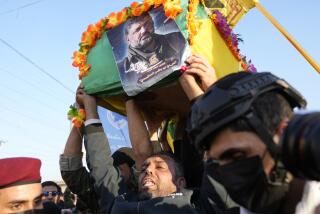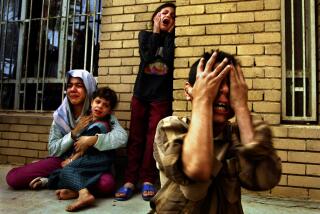Buildup falling short in Iraq
- Share via
BAGHDAD — In the Ubaidi neighborhood in the eastern part of this city, American soldiers hired a local Iraqi to clean the Porta-Potties at their combat outpost. Before the man could start, members of the local Shiite militia threatened to kill him.
Today, the Porta-Potties are roped off, and the U.S. soldiers, who could not promise to protect their sewage man, are forced to burn their waste.
As part of the Bush administration’s troop “surge” strategy, the U.S. unit here had moved into an abandoned potato chip factory hoping to push out the militia, protect existing jobs and provide stability for economic growth. Instead, militia members stymied development projects, cut off the water supply and executed two young Iraqi women seen talking to U.S. soldiers, sending a powerful message about who really controls Ubaidi’s streets.
In the next few days, the Bush administration is scheduled to release a preliminary assessment of its overall Iraq strategy. Officials may point to signs of progress scattered across the country: a reduction in death-squad killings in Baghdad, agreements with tribal leaders in Al Anbar province, offensives north and south of the capital.
President Bush defended his strategy Tuesday, demanding Congress give his administration more time and insisting that America can “win this fight in Iraq.” To underscore his request, Bush sent top aides to lobby lawmakers on Capitol Hill.
But as the experience of the troops in Ubaidi indicates, U.S. forces so far have been unable to establish security, even for themselves. Iraqis continue to flee their homes, leaving mixed areas and seeking safety in religiously segregated neighborhoods. About 32,000 families fled in June alone, according to figures compiled by the United Nations and the Iraqi government that are due to be released next week.
U.S. forces have staged offensives to push insurgents out of some safe havens. But many of the insurgents have escaped to new areas of the country, launching attacks where the U.S. presence is lighter.
And there has been no sign of any of the crucial political progress the administration had hoped to see in Iraq.
U.S. commanders are painfully aware that they are running out of time to change those realities. Army Gen. David H. Petraeus, the top American commander in Iraq, has made several efforts to slow the clock in Washington. Each time, it has sped up.
The full complement of the “surge” arrived in Iraq last month, bringing the total to 28,500 additional troops. Military officers originally hoped to have until 2008 before they had to render a verdict on the strategy. Then the Washington timeframe shrank to September. Now, it is shrinking further, with Congress demanding answers even sooner.
Supporters of the troop buildup insist that small steps could grow into larger and more long-term successes if lawmakers are patient.
“Right now we are three weeks into this. It’s not like flipping a light switch,” said a military officer in Baghdad, expressing the frustration of many commanders. “Time has to be given for things to work.”
Commanders point to Ramadi, the capital of Al Anbar province, as a showcase for the kind of results the military wants from the current strategy. Once a battlefield, the city is now largely peaceful, calm enough that in March, Iraqi Prime Minister Nouri Maliki was able to pay his first official visit.
But military officers stress that it took about nine months of sustained effort to make Ramadi a relatively pacified city. And with its volatile mix of Sunni and Shiite Muslims, Baghdad presents a far more complex challenge than all-Sunni Ramadi.
The interim progress report that Bush promised to release this week is likely to emphasize the success the military has had in killing Sunni militants in the “Baghdad belts,” the cities and towns that dot the major rivers and highways leading to the capital. In recent weeks, the newly arrived U.S. forces have been focused on fighting members of Al Qaeda in Iraq, a militant Sunni group made up of Iraqis and foreign fighters.
Top generals say the strategy is crucial to securing Baghdad. Only by controlling the routes into the capital, and denying militants safe havens, can the U.S. and Iraqi militaries keep out the car bombs that stoke sectarian violence inside the capital.
But leading Iraqis are less sure of the strategy.
Mahmoud Othman, a Kurdish member of the Iraqi parliament, said the U.S. approach may be successful at weakening Al Qaeda in Iraq. But he said Americans would not be able to solve Iraq’s sectarian conflict or stop clashes between armed groups in Baghdad neighborhoods.
“The surge has an important effect in fighting Al Qaeda,” the independent politician said. “On the Sunni-Shiite conflict, it hasn’t had any effect.... Extremist Shiites and Sunnis are fighting each other. The Americans can’t stop this.”
U.S. officials have made little, if any, progress with their persistent calls for Iraqi officials to take steps toward reconciliation between Shiites and Sunnis.
Key administration officials, most prominently Defense Secretary Robert M. Gates and Vice President Dick Cheney, have visited Iraq to push for passage of an oil-revenue sharing law, provincial elections and reform of rules barring members of the former ruling Baath Party from government jobs.
But the Iraqi government is bogged down by fighting among Shiite, Sunni and Kurdish parties. It is unclear whether the oil law, the one piece of benchmark legislation still given hopes for passage before September, will reach a vote any time soon.
The number of death-squad killings in the capital, one sign of sectarian divisions, is down from earlier this year. But the number remains roughly at the level seen after the 2006 bombing of Samarra’s Golden Mosque, which served as a catalyst for the extreme sectarian violence.
In Baghdad, the number of bodies found dumped in the streets dropped to 540 last month from 830 in January. Some American officers say those numbers could rise again. And others say that the decline may simply represent the depressing reality that most Baghdad neighborhoods are now segregated, meaning there are fewer people left for death squads to kill.
Maj. Gen. Joseph Fil Jr., the commander of U.S. forces in Baghdad, said that American troops at the end of June controlled about 42% of the city’s neighborhoods, up from 19% in April.
But to many Iraqis, that is little comfort.
“The Americans do not make me feel safe,” said Amin Sadiq, a 30-year-old Shiite worker in the Ghadeer neighborhood of east Baghdad. “When you hear the speeches of the top U.S. military leaders, you think that everything is ideal and perfect and Iraq will be better. But when you see how the U.S. soldiers behave, I really feel I should not trust the leaders.”
The American military has helped bring a tense truce in some areas, but has not re-integrated once-mixed neighborhoods.
The western Baghdad neighborhood of Ghazaliya, once a prosperous mixed middle-class area, was riven by sectarian violence in 2006. It is now divided between Shiites in the northern end and Sunnis in the south, with the U.S. military stuck in the middle, trying to keep the peace.
“Last year, things were bad. This year is worse than before,” said a man in his 50s who identified himself as Qais Qaisi.
The presence of Iraqi and American security forces means that Sunnis cannot fight back against the Shiite militias, which have the tacit support of the Iraqi army unit in the area, Qaisi said. But he nevertheless voiced concern about a possible American pullout.
“If the multinational forces withdraw, there will be very bloody sectarian battles,” he said.
Military officers routinely say that improving the economy is a prerequisite to improving security. And U.S. forces, by putting up barriers and controlling traffic, have been able to reopen some marketplaces that had been targeted by suicide bombers. Although that has allowed some neighborhood commerce, success with other projects has proved more elusive.
The Pentagon is working to reopen state-owned factories and has identified several dozen that can be renovated and restarted. But that work is slow, and many residents say they see few improvements in their neighborhoods.
Although U.S. forces have been able to overcome militia threats and start small neighborhood projects such as installing streetlights, they are not able to initiate larger undertakings.
“We aren’t doing anything meaningful,” said one mid-level noncommissioned officer. “Where are the real projects? We aren’t offering these people enough safety, or money, or jobs.”
Amid the political setbacks and continuing violence, however, there are signs of relative calm in some areas.
Earlier this year, the streets of Baghdad were desolate at sunset. Now, in places, there are signs of life.
In Yarmouk, a neighborhood in west Baghdad, 18-year-old Ahmed Shakir used to see bodies on the street every day. Snipers fired from hidden perches and gunmen clashed with U.S. and Iraqi soldiers. But last month, after weeks of U.S. patrols, his neighborhood started to feel safe -- safe enough for Shakir to stay outside on the basketball court until 8:30 p.m.
“It is usually me and three of my friends, we always go play basketball,” he said. “Now we have U.S. and Iraqi patrols roaming the streets every day. If they continued doing this, things will remain better. If not, then it will get worse for sure.”
--
ned.parker@latimes.com
Times staff writers Saif Hameed, Zeena Kareem, Mohammed Rasheed and Wail Alhafith contributed to this report.
More to Read
Sign up for Essential California
The most important California stories and recommendations in your inbox every morning.
You may occasionally receive promotional content from the Los Angeles Times.










